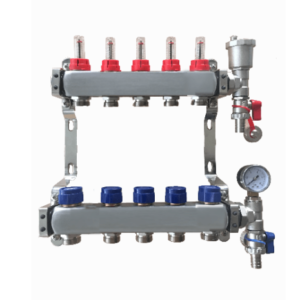5 Advantages & Disadvantages of Underfloor Heating You Didn’t Know
There is no doubt about it – Underfloor Heating is getting increasingly popular every year and becoming standard in most new builds as well as being retroactively fitted on older properties.
Let’s take a look at some the advantages and disadvantages of Underfloor Heating that perhaps you didn’t know.
Advantages of Underfloor Heating:
- Efficiency!
Unquestionably, both Water and Electric systems are far more efficient than traditional radiator systems. Traditional radiator system operate at 65-75 °C with flow coming directly from your boiler. Wet underfloor heating operates at a much lower temperature, usually between 35-55°C. Water temperature is mixed using a blending valve, requiring a lower output from your boiler.
Radiators only heat up the area around them first leaving rooms prone to cold spots. Underfloor heating heats up the entire floored area – so no cold spots.
- Easy to run
Generally, underfloor heating requires very little maintenance once up and running and most systems come with a lifetime warranty.
Additionally, just about any system you order will come with a form of smart thermostat – so you decide when the heating comes on and off. Plus, most smart thermostat brands have apps for your iPhone or Android device so you can even control your heating when you are far from home.
Get that heating turned on as you make your way back from work!
- Works with all floor types
Regardless of the type of floor already in your home, be cement, laminate, wood, tile or stone – rest assured that the underfloor heating system you choose will work with it.
- Safety and Comfort
Heat from underfloor heating systems is much more comfortable and evenly spread compared to that of a traditional radiator – the air is fresher and more oxygen rich, plus there is no need to worry about the little ones hurting themselves on a hot radiator.
- Easy to install
Water systems can be easy to install if part of a renovation while some Electric system installs, depending on the size of the room, can be done as a DIY project. Remember to always seek advice from us and ensure you speak to a fully qualified plumber or electrician before carrying out any work.
Disadvantages of Underfloor Heating:
- Cost to install
Cost will vary depending on the system you ultimately decide to go for, plus you will need to take into account the hourly costs for either the plumber or electrician. As a general rule, water systems are 2-3 times more expensive compared to an electric installation and is usually done as part of a bigger overall renovation or retrofit.
- Time to install
Normally, an electric install can take some time due to the self-levelling compound that is generally required. It needs to completely dry before the floor covering can be put in place. A water based underfloor heating systems takes longer but as it is usually part of bigger renovation, then this does not matter too much.
- Floor height issue
Any underfloor heating system normally means that your floor height will be increased by a few cm’s. Plus any insulation boards that you decide to put down will also contribute to the floor size increasing. Just something to bear in mind.
Overall, is it worth it?
Unquestionably, yes! You get a home with evenly spread warmth and no radiator cold spots. Long term – you will save money on your heating bills as underfloor heating is 25% more efficient than traditional radiators.
Who are we?
VPS Underfloor Heating are able to answer any question you might have in regards your upcoming project or installation and stock a range of top-quality underfloor heating products from some of the most recognised names in the business including: Grundfos, Heatmiser, ProWarm, ESBE and Salus Controls.
Give us a call on 0141 459 3141 to talk to one of the team or choose one of the options below and attach your plans and we’ll get back to you with a breakdown of what you’ll require to get your installation up and running.







